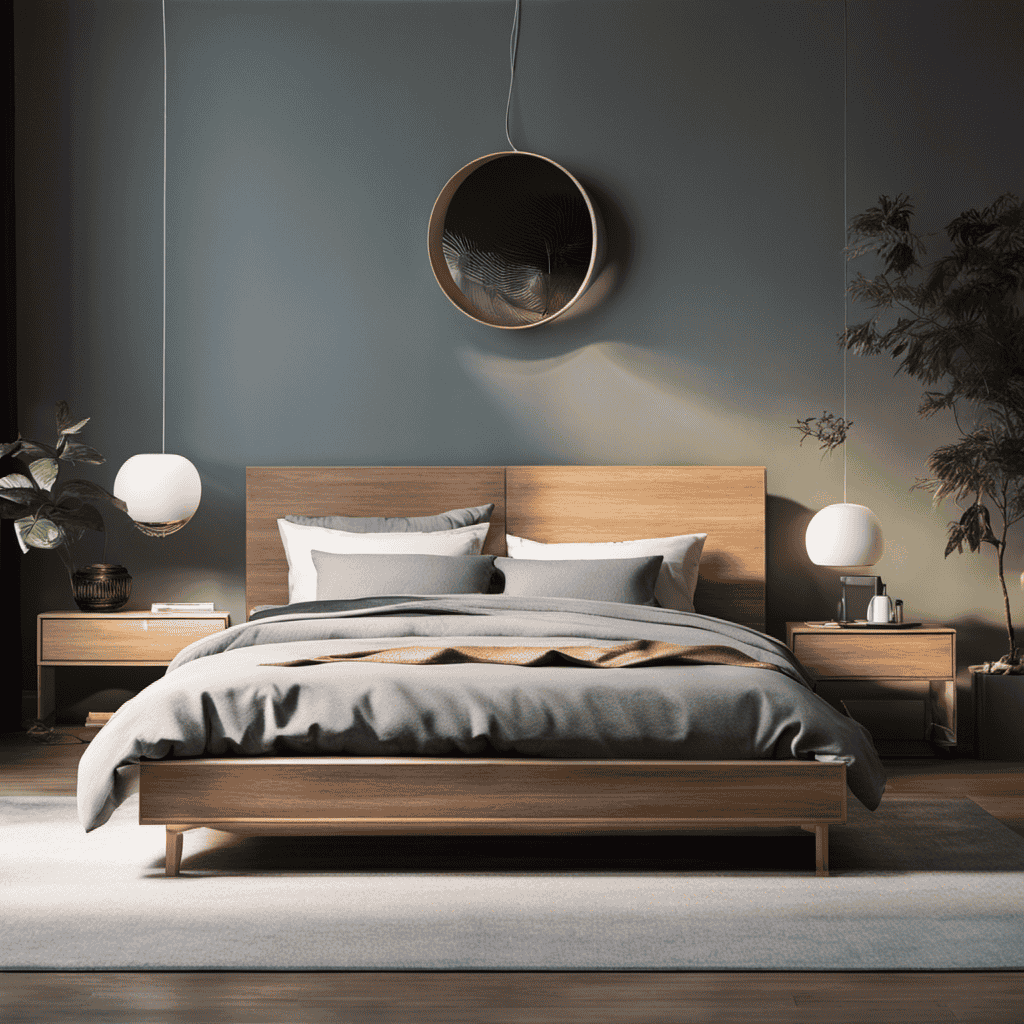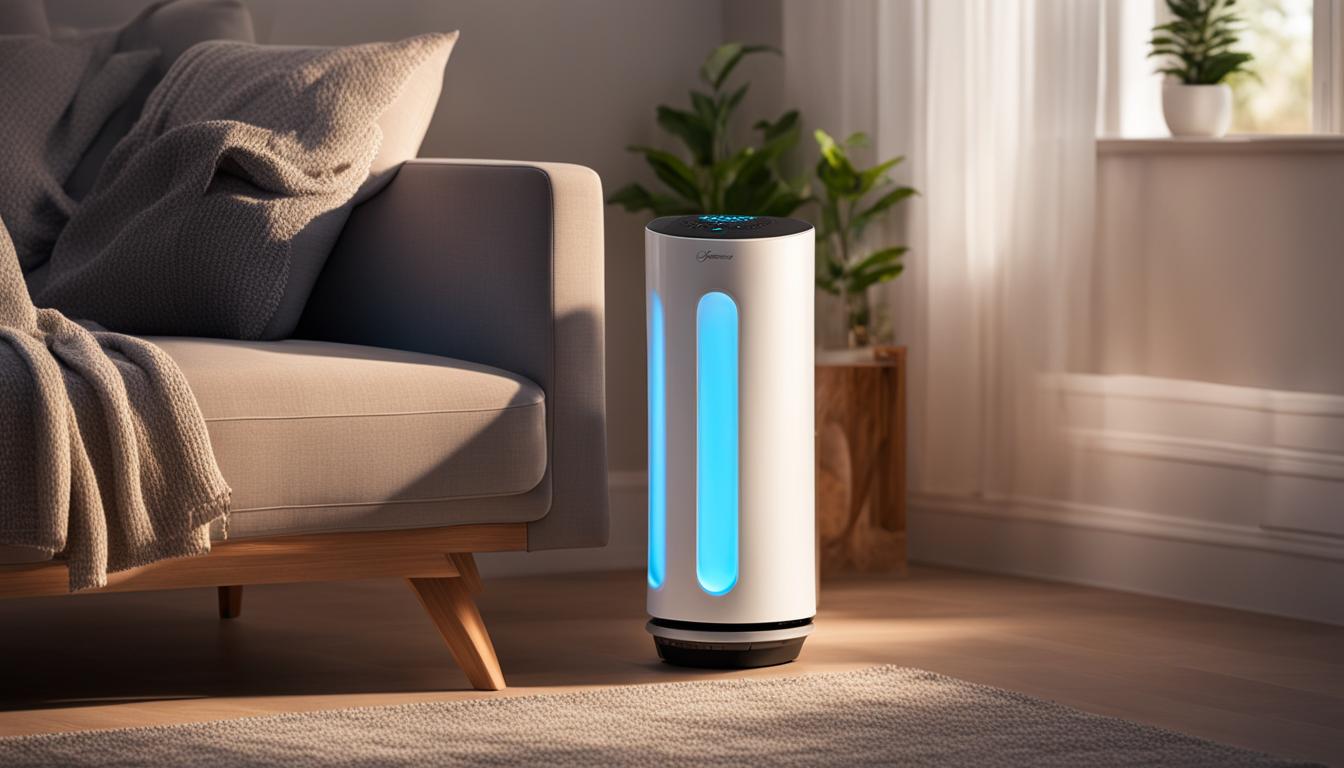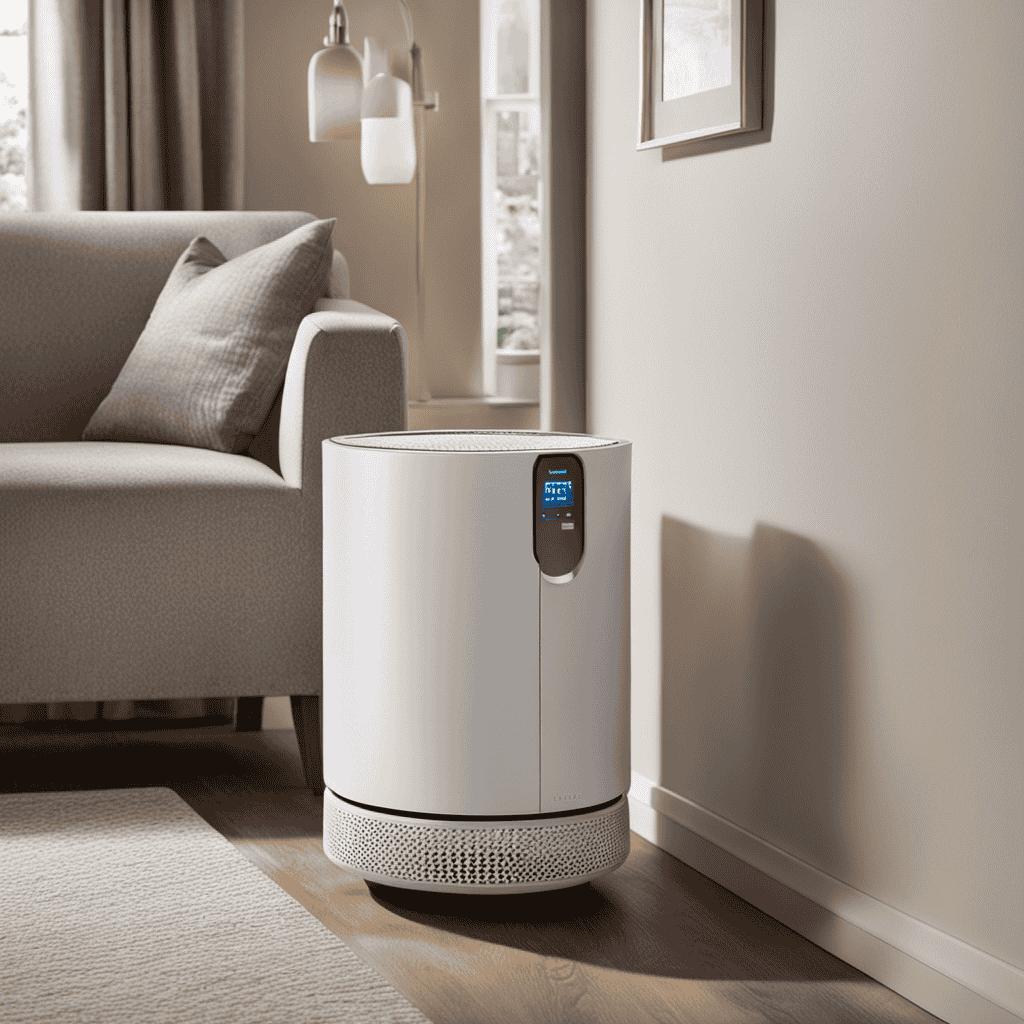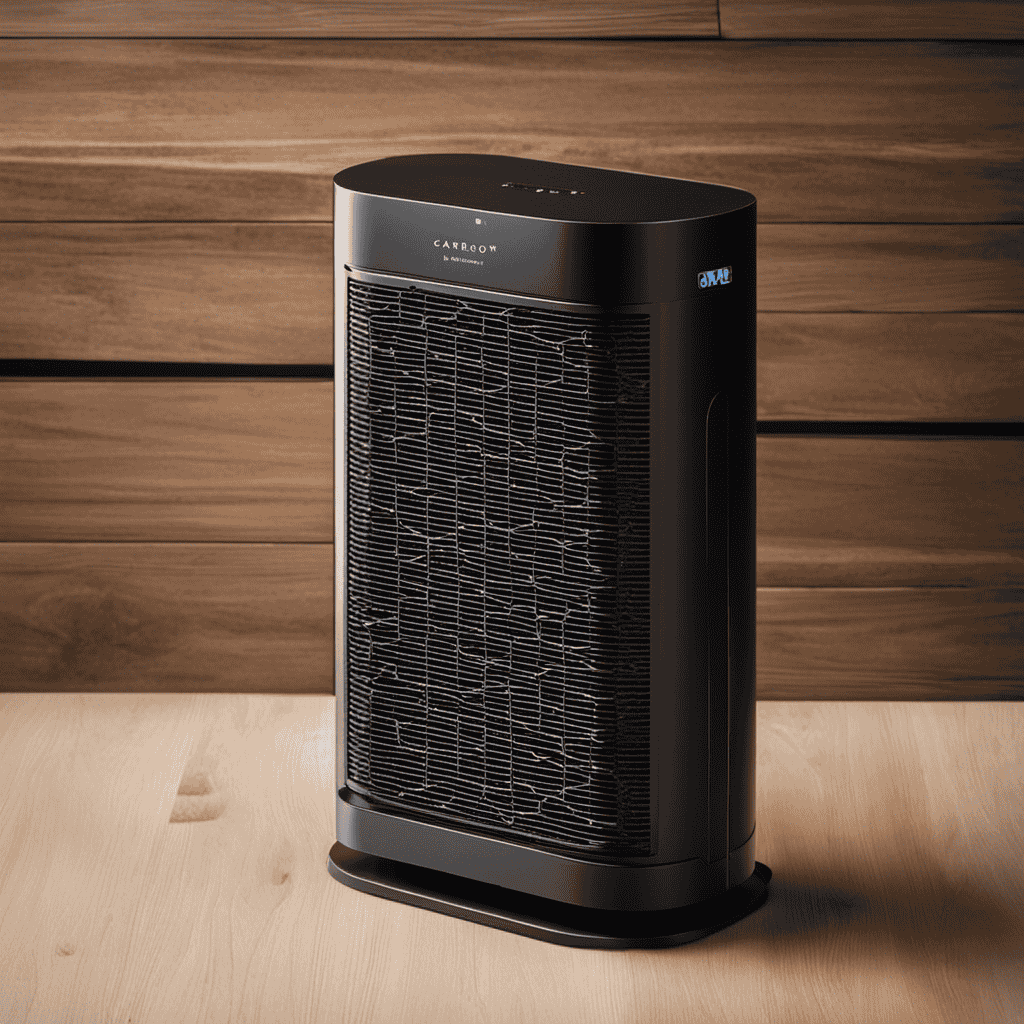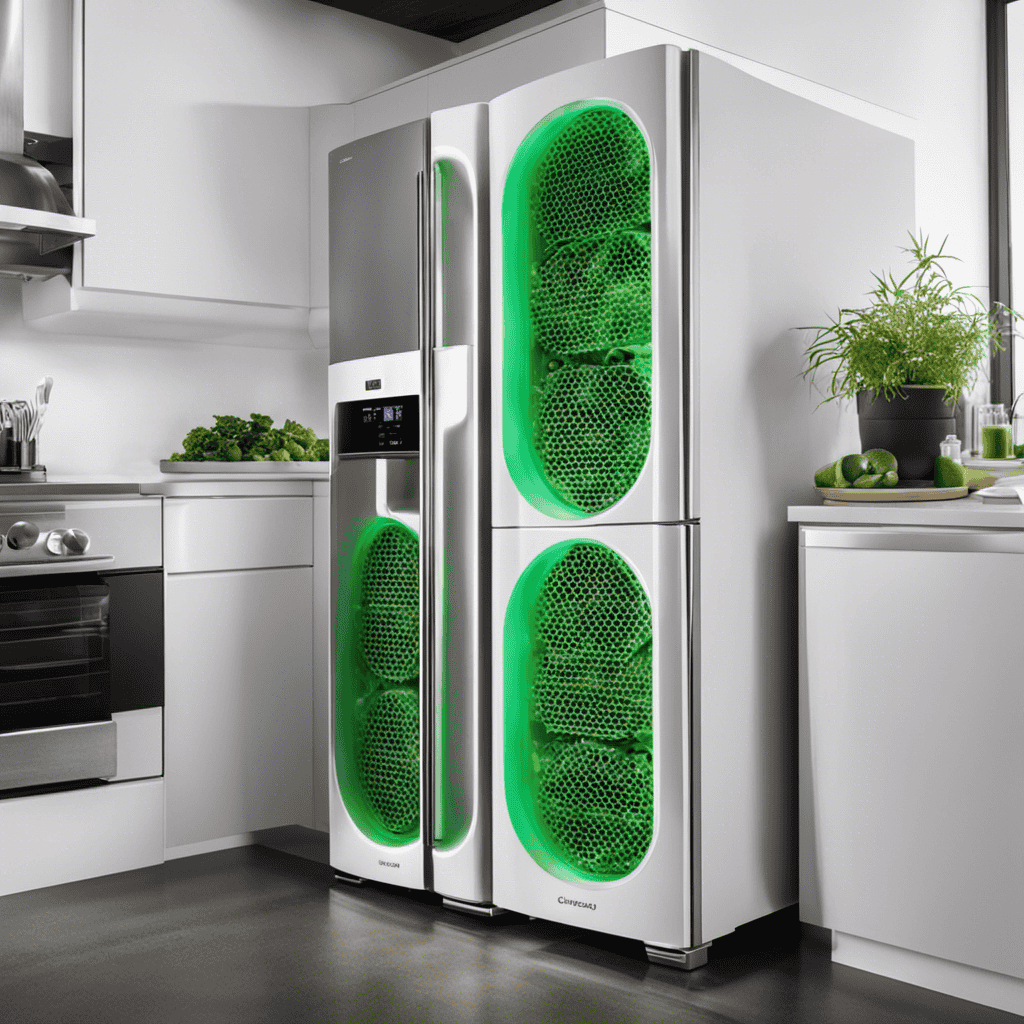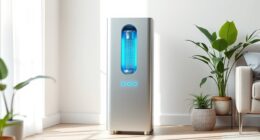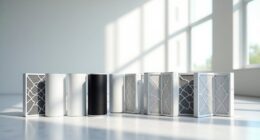Hey! Are you interested in learning about the advantages of using an air purifier? Let me tell you, it can make a significant difference.
I’ve personally experienced the health benefits, like allergy relief and improved air quality. Trust me, this little device is a respiratory superhero, tackling indoor pollutants and eliminating those pesky odors.
If you’re all about breathing in clean, fresh air, stick around. We’re about to dive deep into the evidence-backed wonders of air purifiers.
Let’s get started!
Key Takeaways
- Air purifiers reduce the risk of respiratory illnesses by filtering out airborne particles like dust, pollen, and pet dander.
- Air purifiers can improve indoor air quality and protect overall health.
- Air purifiers effectively reduce allergens and provide relief for those with allergies.
- Air purifiers filter out harmful particles and improve respiratory health, leading to better sleep and peace of mind.
Health Benefits
An air purifier can help you breathe cleaner air and reduce the risk of respiratory illnesses. Airborne particles, such as dust, pollen, and pet dander, can trigger allergies and respiratory symptoms in sensitive individuals. These particles can also carry viruses and bacteria, increasing the chances of respiratory infections. By filtering out these harmful particles, air purifiers can improve indoor air quality and protect your health.
When we breathe in contaminated air, our immune system works hard to defend our bodies against potential threats. However, continuous exposure to airborne particles can overload our immune system, leading to chronic inflammation and respiratory problems. Air purifiers play a crucial role in reducing this burden on our immune system by removing these particles from the air we breathe.
Studies have shown that air purifiers can effectively reduce levels of airborne particles, including allergens and pollutants. For example, a study published in the Journal of Allergy and Clinical Immunology found that using air purifiers in homes significantly decreased indoor levels of airborne allergens like pollen and dust mites.
Allergy Relief
When it comes to indoor air quality, one of the key benefits of using an air purifier is that it helps to create cleaner air in your home. By filtering out pollutants and contaminants, an air purifier can effectively reduce allergens in the air, providing relief for those who suffer from allergies.
This improvement in air quality can have a direct impact on respiratory health, helping to alleviate symptoms and improve overall well-being.
Cleaner Indoor Air
To breathe cleaner indoor air, you should consider using an air purifier. Air purifiers are equipped with advanced air purification technology that effectively controls air pollution.
Here are some reasons why investing in an air purifier can greatly benefit you:
-
It removes harmful particles: Air purifiers use filters to trap and remove pollutants such as dust, pollen, pet dander, and smoke from the air, resulting in cleaner and healthier indoor air.
-
It reduces odors: Air purifiers equipped with activated carbon filters can effectively eliminate unpleasant odors, leaving your home smelling fresh and clean.
By utilizing air purification technology, air purifiers can significantly improve the quality of the air you breathe indoors. This not only helps to reduce the risk of respiratory issues but also promotes overall well-being.
Furthermore, cleaner indoor air can have a positive impact on your daily life, allowing you to focus better, sleep more soundly, and enjoy a healthier living environment.
Now, let’s explore how air purifiers can effectively reduce allergens.
Reduces Allergens Effectively
If you suffer from allergies, investing in an air purifier can greatly help in reducing allergens in your home. Air purifiers work by filtering out airborne contaminants, such as dust mites, pollen, pet dander, and mold spores, which are common triggers for allergies. These devices use a combination of filters, such as HEPA filters, activated carbon filters, and UV-C light technology, to effectively capture and eliminate these allergens from the air. By continuously circulating and purifying the air in your home, air purifiers provide relief from allergy symptoms and improve indoor air quality. To further demonstrate the effectiveness of air purifiers in reducing allergens, consider the following table:
| Airborne Contaminant | Reduction Rate (%) |
|---|---|
| Dust Mites | 99.97 |
| Pollen | 99.9 |
| Pet Dander | 99.9 |
| Mold Spores | 99.9 |
| Bacteria | 99.99 |
As shown in the table, air purifiers can achieve high reduction rates for various allergens, including dust mites, which are a common cause of allergies. Therefore, investing in an air purifier is a practical and effective solution for dust mite control and overall allergen reduction in your home.
Improves Respiratory Health
For improving your respiratory health, it’s important to consider the effectiveness of an air purifier in reducing allergens and providing relief from allergy symptoms.
Air purifiers are designed to filter out harmful particles in the air, such as pollen, dust mites, and pet dander, which can trigger respiratory illnesses and worsen lung function.
Here are some key benefits of using an air purifier:
-
Cleaner Air: An air purifier can remove up to 99.97% of airborne particles, improving the overall air quality in your home or office.
-
Allergy Relief: By reducing allergens in the air, air purifiers can alleviate symptoms like sneezing, congestion, and itchy eyes, providing much-needed relief.
-
Improved Sleep: Breathing in clean air while you sleep can help you wake up feeling refreshed and rejuvenated.
-
Peace of Mind: Knowing that you are breathing in cleaner air can give you peace of mind and reduce anxiety related to respiratory health.
Investing in an air purifier is a proactive step towards improving your respiratory health and ensuring optimal lung function.
Improved Air Quality
When it comes to creating a healthier breathing environment, reducing allergens and pollutants is key. An air purifier can effectively remove these harmful particles from the air, improving overall air quality.
By using advanced filtration technology, an air purifier can capture and eliminate allergens such as dust, pollen, and pet dander, as well as pollutants like smoke and volatile organic compounds (VOCs).
This ensures that the air we breathe is cleaner and healthier, reducing the risk of respiratory issues and allergies.
Healthier Breathing Environment
To create a healthier breathing environment, you should consider using an air purifier. Air pollution is a major concern in many cities, and it can have a detrimental effect on our health. An air purifier helps to remove harmful pollutants from the air, improving the overall air quality in your home or office.
Here are some reasons why investing in an air purifier can make a difference:
-
Reduces Allergens: An air purifier can capture and eliminate common allergens such as dust mites, pollen, and pet dander. This can provide relief for individuals with allergies or asthma, allowing them to breathe easier.
-
Removes Volatile Organic Compounds (VOCs): VOCs are harmful chemicals that can be found in household products and building materials. Air purifiers with activated carbon filters can effectively remove these compounds, improving indoor air quality.
Investing in an air purifier is a proactive step towards creating a healthier breathing environment, reducing the impact of air pollution, and improving overall air quality.
Reduced Allergens and Pollutants
In my previous section, I discussed how air purifiers help create a healthier breathing environment. Now, let’s delve into the topic of reduced allergens and pollutants, which is another crucial benefit of using an air purifier. Indoor air quality can be compromised by various allergens and pollutants, such as dust mites, pet dander, pollen, mold spores, and volatile organic compounds (VOCs) emitted by cleaning products and furniture. These contaminants can trigger allergies, respiratory issues, and other health problems.
To better understand the impact of air purifiers, let’s take a look at the table below, which highlights common indoor allergens and pollutants and the corresponding air purification technologies that can effectively remove them:
| Allergens/Pollutants | Air Purification Technologies |
|---|---|
| Dust Mites | HEPA Filters |
| Pet Dander | HEPA Filters |
| Pollen | HEPA Filters |
| Mold Spores | HEPA Filters, UV-C Lights |
| VOCs | Activated Carbon Filters |
Odor Elimination
You’ll love how an air purifier eliminates odors, making your home smell fresh and clean. Here are some reasons why air purifiers are effective in odor elimination:
-
Advanced Filtration Technology: Air purifiers are equipped with filters that can capture and remove odor-causing particles from the air. These filters can trap even the tiniest particles, ensuring that your home is free from unpleasant smells.
-
Activated Carbon Filters: These filters are highly effective in removing odors as they contain a large surface area that can adsorb odor molecules. They work like a sponge, absorbing and trapping the odor particles, leaving your home smelling fresh.
-
HEPA Filters: In addition to removing allergens and pollutants, HEPA filters can also capture and eliminate odors. They work by trapping odor-causing particles, ensuring that the air in your home is clean and odor-free.
By using an air purifier with advanced filtration technology, you can effectively control the scents in your home. Additionally, air purifiers can also help reduce respiratory issues caused by poor air quality, such as allergies and asthma.
Transitioning to the next section, let’s explore the benefits of reduced respiratory issues.
Reduced Respiratory Issues
In the previous section, we discussed how air purifiers can effectively eliminate odors from the air. Now, let’s delve into their role in promoting lung health and reducing respiratory issues.
Respiratory disorders, such as asthma, allergies, and chronic obstructive pulmonary disease (COPD), can greatly impact an individual’s quality of life. These conditions are often triggered or aggravated by airborne pollutants, such as dust mites, pollen, pet dander, and mold spores.
By using an air purifier, you can significantly reduce the concentration of these allergens and irritants in your indoor environment, improving the overall air quality. This is especially beneficial for individuals with respiratory disorders, as it helps to alleviate symptoms and prevent flare-ups.
To further understand the impact of air purifiers on respiratory health, let’s take a look at a table summarizing the research findings:
| Study | Findings |
|---|---|
| A 2018 study conducted by the American Academy of Allergy, Asthma, and Immunology | Air purifiers reduced asthma symptoms in children by 71% and improved lung function by 40%. |
| A 2016 review published in the Journal of Asthma and Allergy | Using air purifiers in homes with asthma patients resulted in a 66% reduction in symptoms and a 32% decrease in medication use. |
| A 2019 study published in the International Journal of Environmental Research and Public Health | Air purifiers reduced allergic rhinitis symptoms in adults by 61% and decreased the need for medication by 53%. |
These studies provide compelling evidence that air purifiers can play a crucial role in safeguarding lung health and mitigating respiratory disorders.
Protection Against Indoor Pollutants
To safeguard your health against indoor pollutants, it’s important to understand the role of air purifiers in reducing their concentration. Indoor air quality can be compromised by a variety of pollutants, including dust, pet dander, mold spores, and volatile organic compounds (VOCs). Air purifiers, equipped with effective filtration systems, can help remove these pollutants from the air we breathe, improving the overall indoor air quality.
Here are some emotional benefits of using air purifiers:
-
Peace of Mind: Knowing that the air you and your loved ones breathe is clean and free from harmful pollutants can provide a sense of peace and security.
-
The tranquil feeling of knowing you are taking proactive steps to protect your health and well-being.
-
The relief of knowing that you are creating a safe environment for your family.
-
Improved Health: Breathing in clean air can have a positive impact on your health, especially for individuals with respiratory conditions or allergies.
-
The joy of experiencing fewer asthma or allergy symptoms, such as sneezing, coughing, or wheezing.
-
The satisfaction of minimizing the risk of respiratory infections and other health issues associated with poor indoor air quality.
Can you list the specific benefits of using an air purifier?
Using an air purifier can provide numerous air purifier advantages, such as eliminating allergens, dust, and pet dander from the air, improving indoor air quality, reducing respiratory issues, removing odors, and preventing mold and bacteria growth. It can also create a healthier and more comfortable living environment for you and your family.
Frequently Asked Questions
How Often Should I Clean or Replace the Filters in My Air Purifier?
Cleaning frequency and filter replacement are important aspects of maintaining an air purifier. Regular cleaning helps ensure optimal performance, while filter replacement is necessary to maintain effective air purification.
The frequency of cleaning and filter replacement depends on various factors such as the manufacturer’s recommendations, the level of air pollution, and the usage of the purifier. It is crucial to follow the guidelines provided by the manufacturer to ensure that the air purifier continues to function efficiently and provide clean air.
Can an Air Purifier Completely Eliminate Pet Dander From My Home?
An air purifier can be a valuable tool for pet owners like me who want to reduce pet dander in the home. While it may not completely eliminate pet dander, it can significantly reduce the amount in the air.
Regular maintenance, such as cleaning or replacing filters, is crucial to ensure the air purifier continues to effectively capture pet dander.
When choosing an air purifier, it’s important to look for models specifically designed for pet owners, as they often have features that target pet allergens.
Are Air Purifiers Effective in Reducing the Spread of Airborne Viruses and Bacteria?
Air purifiers have been shown to be effective in reducing the spread of airborne viruses and bacteria. Studies have found that they can capture and eliminate up to 99.97% of particles as small as 0.3 microns. This includes allergens like pollen and dust mites that can trigger allergies, as well as harmful bacteria and viruses.
Using an air purifier can greatly benefit those with allergies and asthma. It provides cleaner air and reduces symptoms.
Can an Air Purifier Remove Harmful Chemicals and Vocs (Volatile Organic Compounds) From the Air?
Using an air purifier has numerous benefits. It effectively removes harmful chemicals and VOCs from the air, ensuring a healthier indoor environment.
Additionally, air purifiers are highly effective in reducing indoor allergens, such as dust, pollen, and pet dander. By capturing and trapping these particles, air purifiers help alleviate allergy symptoms and improve overall air quality.
With their proven effectiveness and ability to promote cleaner air, air purifiers are an essential investment for anyone concerned about their health and well-being.
Are There Any Potential Side Effects or Risks Associated With Using an Air Purifier for Extended Periods of Time?
Using an air purifier for extended periods of time may have potential health risks and long-term effects. Continuous exposure to the purified air could lead to dryness or irritation of the respiratory system.
Additionally, some air purifiers emit ozone, which can be harmful when inhaled in high concentrations. It is important to choose an air purifier that meets safety standards and to use it according to the manufacturer’s instructions to minimize any potential risks.
Conclusion
In conclusion, an air purifier is like a guardian angel, silently working to protect our health and well-being.
With its advanced filtration system, it removes allergens, pollutants, and odors, creating a sanctuary of clean and fresh air.
Its magical powers reduce respiratory issues and shield us from harmful indoor pollutants.
Like a shield of armor, it defends us against the invisible enemies lurking in the air.
So, invest in an air purifier and let it be your secret weapon in the battle for a healthier and happier life.
